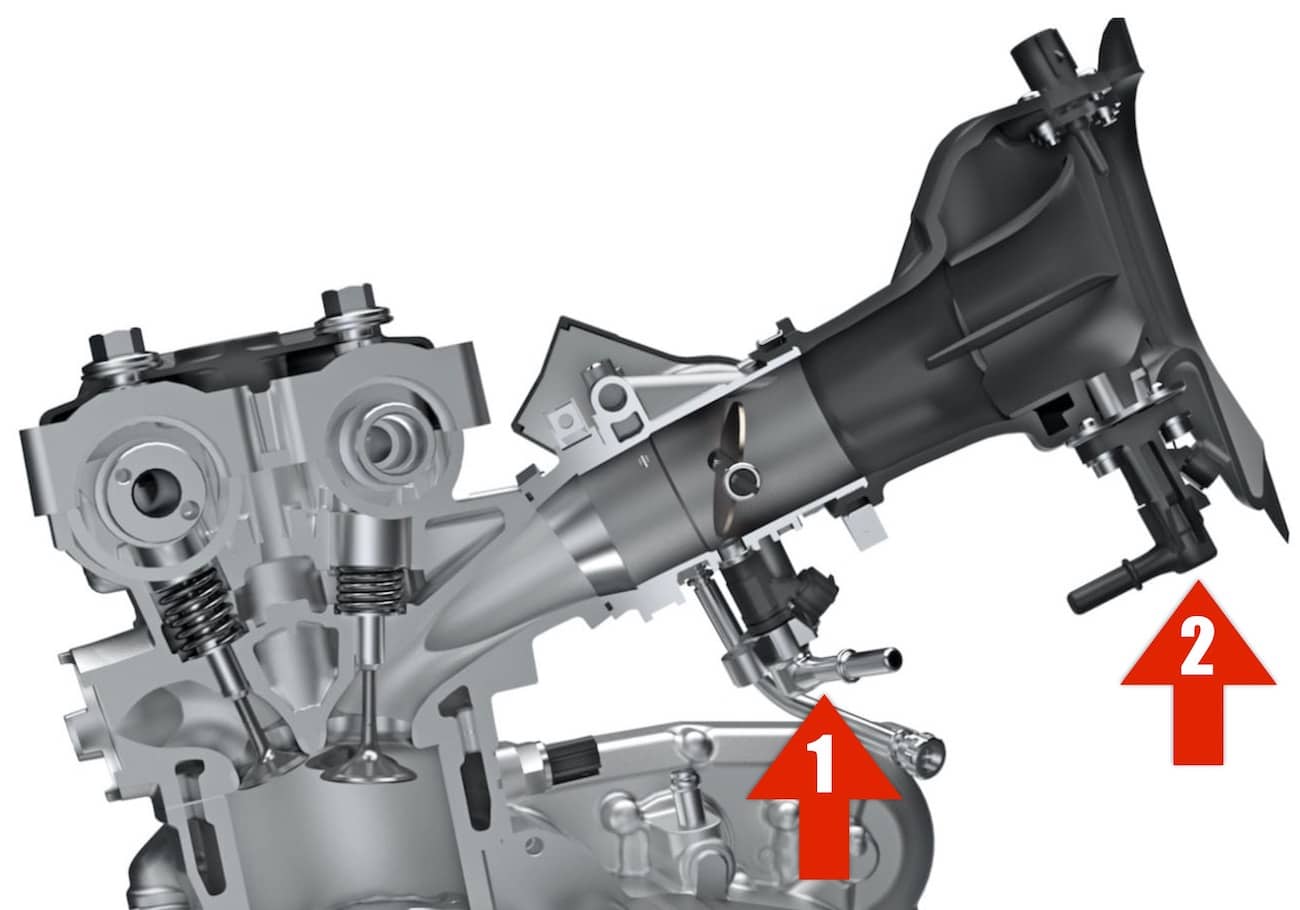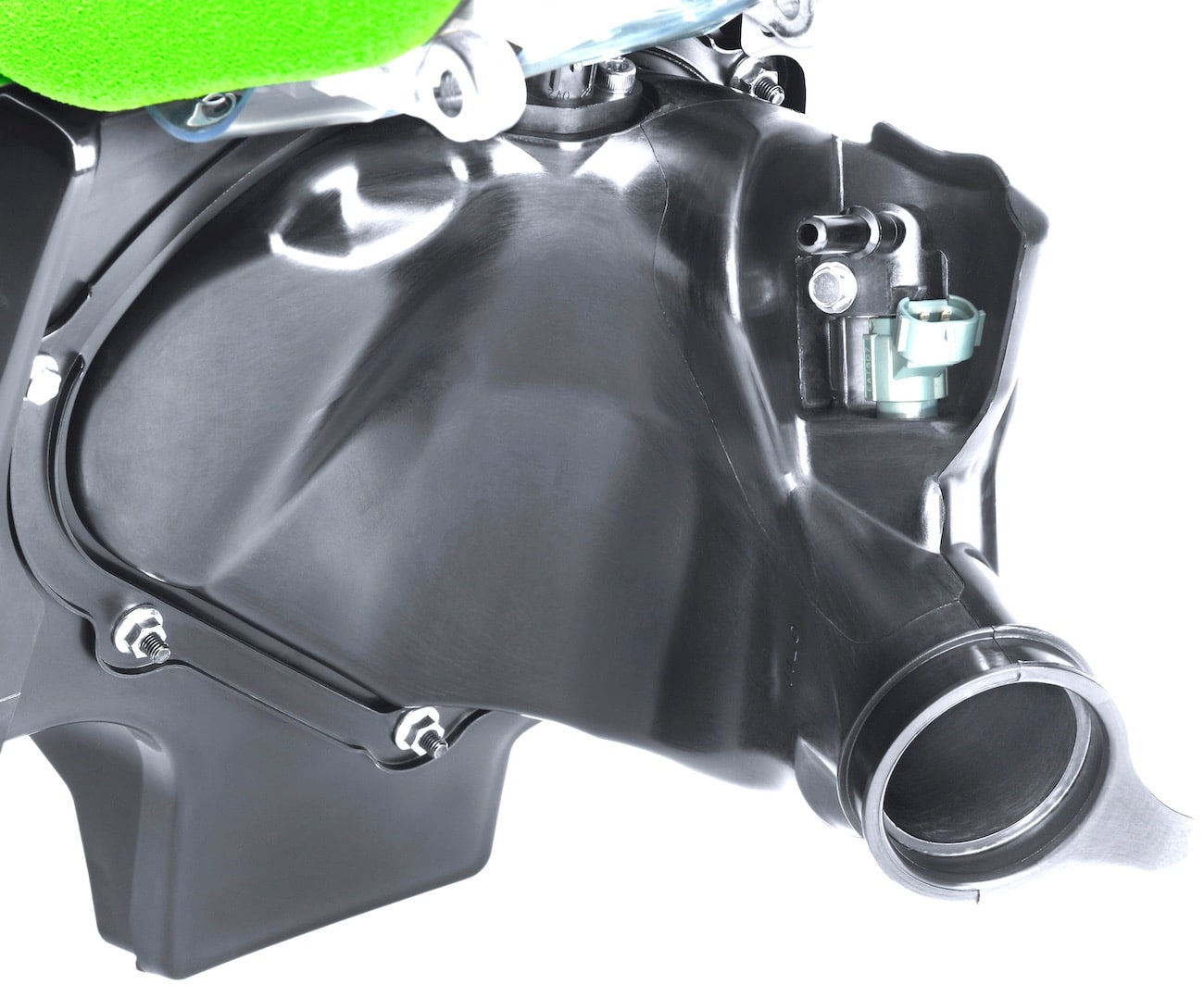ASK THE MXPERTS: TWO NOZZLES, BUT ONLY ONE THROTTLE BODY, HOW DOES THAT WORK?
 The red arrows point to the 2022 Suzuki RM-Z250’s two fuel injection nozzles. #1 in the throttle body and #2 in the airbox.
The red arrows point to the 2022 Suzuki RM-Z250’s two fuel injection nozzles. #1 in the throttle body and #2 in the airbox.
Dear MXA,
I’ve read that the Suzuki RM-Z250 has two fuel-injector nozzles, but only one throttle body. How does that work, and what does it do?
First, let’s not give Suzuki credit for the concept of dual-fuel injection in motocross bikes. The Kawasaki KX250F has had dual injectors since 2012. Here is the quick take on how dual-fuel works. On each intake cycle, the engine draws a breath of air from the intake tract, which can be viewed as a long rubber tube of air. At low rpm, the engine is taking quick little breaths and only using a fraction of that long column of air. A single injector nozzle must be placed near the intake port to deliver fuel at low rpm. At high-rpm, however, when the engine is drawing in the whole long column of air, a secondary injector can take advantage of the added volume of the long column of air. Atomization is what counts with the fuel/air mixture, and dual injectors can keep up with the needs of both low- and high-rpm running.
Spraying fuel with an injector nozzle as far away from the intake port as possible gives the fuel time to atomize while being tumbled in the natural turbulence of the intake tract. It is also claimed that the upstream injector cools down the intake charge to make the mixture denser with oxygen, which translates into more power.
Don’t confuse the KX250F and RM-Z250 dual-fuel systems with Honda’s Dual-Timing injection and KTM’s Split-Injection system. The Honda and KTM systems do not use two injector nozzles, nor do they meter the amount of fuel between separate systems. Instead, Honda’s and KTM’s injection systems separate the spray from their single injector into two charges. The first charge is a short-duration spray that is used to cool the back of the intake valves’ heads for more oxygen. It is followed by a second spray of fuel (from the same injector nozzle).
 The Kawasaki KX250’s second nozzle mounts in the air boot and directs fuel into the air rushing into the engine.
The Kawasaki KX250’s second nozzle mounts in the air boot and directs fuel into the air rushing into the engine.
Both of the 2019-2022 Suzuki RM-Z250 injector nozzles have the same output capacity. The first injector is spraying fuel until 7000 rpm. At 7000 rpm, the upstream injector kicks in and gradually increases its fuel delivery, while the first injector gradually tapers off. When the bike is running wide open, only the upstream injector is working—because the rpm is high and the demand for air is great—so the longer column provides the extra volume of air.
Dual injectors make CPU programming more critical. The two injectors must blend together seamlessly to optimize fuel delivery. When Kawasaki first introduced its dual-fuel system, several non-Kawasaki race teams tried to copy it on their race bikes. It didn’t work at first because they didn’t have the proper ECU mapping. Since then, Twisted Development’s Jamie Ellis has perfected a system that can be retrofitted on almost any modern fuel-injected 250cc four-stroke. Jamie figured out the proper “pulse width” of the two injectors’ spray timing. Making any fuel-injection system work is a matter of mastering the lag time from when the CPU sends the signal to turn the injector on and when it actually turns on. This lag can be a millisecond or more. With a typical pulse width of only 2 milliseconds at best, a delay of 1 millisecond is substantial. On a single-injector engine, the engineers must figure out an average lag time and increase the pulse width accordingly to cover all the bases. With two simultaneously operating injectors, the pickup delay can be covered up by the difference between fuel traveling a short distance and fuel coming from farther away.
As for your original question, the 2019-2022 Suzuki RM-Z250 and KX250 have one injector nozzle located close to the combustion chamber, in the throttle body, for low-rpm running (when the need for air volume is less); and a second injector is mounted farther away so that it can deliver a greater volume of air down the intake tract at higher air velocities.




Comments are closed.